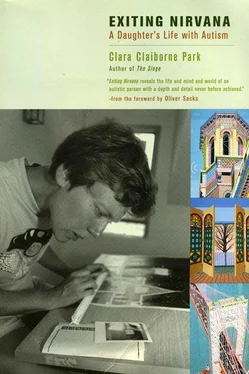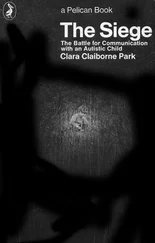Clara Park - Exiting Nirvana
Здесь есть возможность читать онлайн «Clara Park - Exiting Nirvana» весь текст электронной книги совершенно бесплатно (целиком полную версию без сокращений). В некоторых случаях можно слушать аудио, скачать через торрент в формате fb2 и присутствует краткое содержание. ISBN: , Жанр: Психология, на английском языке. Описание произведения, (предисловие) а так же отзывы посетителей доступны на портале библиотеки ЛибКат.
- Название:Exiting Nirvana
- Автор:
- Жанр:
- Год:неизвестен
- ISBN:0-316-69117-8
- Рейтинг книги:4 / 5. Голосов: 1
-
Избранное:Добавить в избранное
- Отзывы:
-
Ваша оценка:
- 80
- 1
- 2
- 3
- 4
- 5
Exiting Nirvana: краткое содержание, описание и аннотация
Предлагаем к чтению аннотацию, описание, краткое содержание или предисловие (зависит от того, что написал сам автор книги «Exiting Nirvana»). Если вы не нашли необходимую информацию о книге — напишите в комментариях, мы постараемся отыскать её.
All illustrations are by Jessy Park.
Exiting Nirvana — читать онлайн бесплатно полную книгу (весь текст) целиком
Ниже представлен текст книги, разбитый по страницам. Система сохранения места последней прочитанной страницы, позволяет с удобством читать онлайн бесплатно книгу «Exiting Nirvana», без необходимости каждый раз заново искать на чём Вы остановились. Поставьте закладку, и сможете в любой момент перейти на страницу, на которой закончили чтение.
Интервал:
Закладка:
But it was not such distress that defined her. It came, it passed, it was over, its transitoriness as mysterious as its intensity. Next day it could become a subject of cheerful conversation — next day, or ten years later. «No wonder I cried!» she’ll say, her voice alive with her characteristic rising, positive, happy intonation.
She is happy still. I can’t think of another woman in her forties who is more content with who she is, less likely to question how she lives or what she does. Though she no longer circles a spot or snakes a chain up and down, she still has her sources of strange, private pleasure. Things once bad may even become good, as has happened with fluffy-in-the-middle words. Last year she was delighted to find «nuclear» and «nucleus» to add to a list including «radio», «valve», «molar» («I saw that on June ’91»), and «un-welcome». And now, «remembrance».
It is, however, far more important that over the years such mysterious pleasures — and pains — have been joined by others more «normal», more recognizable to other human beings, more connected to other human beings, as she has learned, slowly and imperfectly, to function not only beside them but with them, in a shared world. That is her achievement, made possible (like all the achievements of profoundly handicapped people) by the work and support of many others — young people who lived with us and became wise and resourceful therapists; patient teachers; accepting, helpful people in her workplace and her community. And always, first and last, her family — ourselves, her mother and father, with whom she still lives, and her sisters and brother. That is what this forty-year journey has been about.
It has not been about a miraculous recovery, though selective narration could give that illusion. It has not been about happiness either; in very real ways it has been about its opposite. It has been about growth, and there is no growth in Nirvana. The world we share, the only world we had to offer that wordless baby, is our common world of risk, frustration, loss, of unfulfilled desire as well as of activity and love. We could not leave Jessy to her empty serenity. We would not, as was often recommended in those days, institutionalize her «for the sake of the other children», to spend her days somewhere in a back ward, rocking. We would keep her with us, entice, intrude, enter where we were not wanted or needed.
It was like assaulting a walled city. I called my book about it The Siege, choosing the title two years before I’d ever heard of an empty fortress. The metaphor is that strong. Four years, five years, six years — we did get into the walled city. But of course when she began to look at us, to recognize us, to need us — even, in her way, to love us — this was no goal achieved but only a beginning. The siege metaphor became transmuted into a more ordinary one. Siege into journey.
When Jessy was small there were no real explanations for the condition Leo Kanner, the noted child psychiatrist, had identified in 1943 and called Early Infantile Autism. He had observed and described those eerily detached children; he had thought that such a profound inability to relate to others was probably «innate».
But he had also speculated in a different direction; the phrase «refrigerator parents» was also his. Twenty-five years later, before the newly formed National Society for Autistic Children (now Autism Society of America), he would repudiate this explanation in words none of us who heard him would ever forget: «Herewith I especially acquit you people as parents». But though he called The Empty Fortress «the empty book», the ghost of parental responsibility was not so easily laid to rest. [3] Leo Kanner, „Autistic Disturbances of Affective Contact“ (1943), in Classic Readings in Autism, A. M. Donnellan, ed. (New York: Teachers College, Columbia University, 1985), p. 50. Kanner spoke at a meeting of the National Society for Autistic Children, July 17–19, 1969.
Nor was there as yet research to offer convincing support for alternative hypotheses.
In the more than thirty years since then, evidence has accumulated for more merciful — and realistic — explanations. Suppose an impairment in what we now call information processing. A new baby is flooded with information — what William James called a «buzzing, blooming confusion» of light, shadow, color, sound, constantly changing. And if this baby’s brain is not ready to do what other babies do so naturally that we don’t even think about it, to make sense of that confusion of sense impressions, to resolve it into what it can recognize as faces, voices, which experience can render familiar and welcome? What then? Suppose she cannot do what other babies do instinctively, understand the changing expressions on those faces, the tones of those voices. Might she not prefer the security of a world she could make sense of, a world that didn’t change, or changed predictably — a world not of faces, not of voices, certainly not of words, but of spots on the floor and snaking chains? Of clear, unchanging, identifiable shapes and colors? And when that secure order was disrupted, might she not be desolate?
Supplement this with another conceptualization. When the anthropologist Clifford Geertz summarizes «the critical features of human thinking», he does not jump forward to what we might be expecting: sequencing of events, perception of cause and effect, induction and deduction. What he lists is far more fundamental: «joint attention with others to objects and actions, attribution of beliefs, desires, and emotions to others, grasping the general significance of situations». [4] Clifford Geertz, „Learning with Bruner“, New York Review of Books, April 10, 1997.
Shall we call this, with the British specialist Uta Frith, a «theory of mind»? It seems too grand a phrase to describe what little tiny average babies, as soon as they are born, get busy developing. Yet these are the skills, this is the natural human knowledge without which the social world, that interwoven tissue of meanings into which every baby is plunged, is unintelligible.
These conceptualizations were not available when Jessy circled her spot; now we see how well they explain the challenges she, and we, lived with. For overwhelmingly these challenges were social. As she grew, we were to discover how little trouble Jessy had with sequencing, cause and effect, induction and deduction. But «joint attention»? It is such a simple thing. A mother and a baby look at a picture book together. The mother points; soon the baby will too. Or they play clap hands or peekaboo; mother and baby laugh. Yet learning cannot take place without these «critical features of human thinking». We learn by imitation; imitation is a social act. It does not occur in Nirvana, where there is neither need nor opportunity for joint attention.
By the time Jessy was six and seven she could put two or three words together; she heard, even understood a little of what we said to her. How could we teach her to understand more, speak more intelligibly? Further, how could we motivate her to do the simple activities it became clear she was capable of doing? She could count, even subtract; the washcloth anxiety proved that.
She could notice the slightest deviation from a pattern. Clearly she could set the table. But why should she? To imitate her sisters? To please her mother? Such natural, social motivators are meaningless without «attribution of beliefs, desires, and emotions to others», without a «theory of mind». At two and a half she had drawn a closed circle, an X, even, astonishingly, a J. Once; six months later she wouldn’t even pick up a crayon. Why should she? Why should anybody do anything? She could distinguish the most subtle shades of color; she did not utter her first adjectives until six, but when they came they were not the commonplace «bad» or «nice», laden with social value. Rather (of two VW’s side by side) she chirped, cheerfully, positively, correctly, «Peacock BLUE car, peacock GREEN car!» Yet later, after I had lured her back into drawing, she would take the first crayon available. Yellow on white? Why not? She drew for her own purposes, not to be visible to others. Sometimes she would even cut up what she had drawn, to join the other three-quarter-inch squares in her sifting carton.
Читать дальшеИнтервал:
Закладка:
Похожие книги на «Exiting Nirvana»
Представляем Вашему вниманию похожие книги на «Exiting Nirvana» списком для выбора. Мы отобрали схожую по названию и смыслу литературу в надежде предоставить читателям больше вариантов отыскать новые, интересные, ещё непрочитанные произведения.
Обсуждение, отзывы о книге «Exiting Nirvana» и просто собственные мнения читателей. Оставьте ваши комментарии, напишите, что Вы думаете о произведении, его смысле или главных героях. Укажите что конкретно понравилось, а что нет, и почему Вы так считаете.



![Майкл Азеррад - Come as you are - история Nirvana, рассказанная Куртом Кобейном и записанная Майклом Азеррадом [litres]](/books/392533/majkl-azerrad-come-as-you-are-istoriya-nirvana-ra-thumb.webp)



![Эверетт Тру - Nirvana - Правдивая история [litres]](/books/399241/everett-tru-nirvana-pravdivaya-istoriya-litres-thumb.webp)




